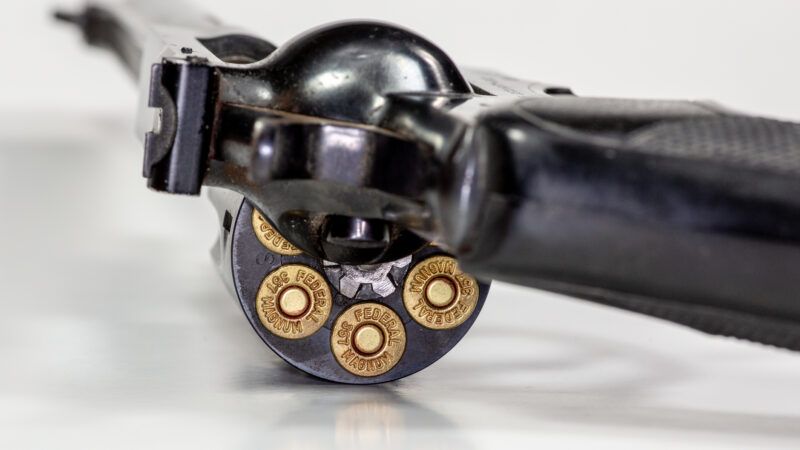Maryland Supreme Court Limits Testimony on Bullet-Matching Evidence
The ruling is likely the first by a state supreme court to undercut the popular forensic technique.

The Maryland Supreme Court ruled Tuesday that firearms experts will no longer be able to testify that a bullet was fired from a particular gun. The decision is likely the first by a state supreme court to undercut the widespread forensic discipline of firearms identification, which is used in criminal cases across the country.
In a 4–3 decision first reported by The Baltimore Sun, the Maryland Supreme Court overturned the murder conviction of Kobina Ebo Abruquah after finding that a firearm expert's trial testimony linking Abruquah's gun to bullets found at a crime scene wasn't backed up by reliable science. In the majority opinion, Maryland Supreme Court Chief Justice Matthew J. Fader wrote that "firearms identification has not been shown to reach reliable results linking a particular unknown bullet to a particular known firearm."
The ruling is a major victory for defense groups like the Innocence Project, which works to overturn wrongful convictions and limit what it calls faulty forensic science in courtrooms. It's also not the only one: Radley Balko recently reported at The Watch on a similar ruling from a Cook County circuit judge in Illinois.
But Tuesday's ruling is the first by a state supreme court limiting such testimony that Tania Brief, a senior staff attorney at the Innocence Project, which filed an amicus brief in the case, is aware of.
"One of the tensions in our work is that the law is always playing catch-up with the current scientific understanding," Brief says. "And this is a real step forward in the law catching up with what the current scientific understanding is."
Forensic firearms identification includes well-established uses such as determining caliber and other general characteristics, but examiners are also frequently called on to testify whether a particular bullet was fired from a particular gun. A gun's firing pin and the grooves on the inside of a gun barrel leave marks on cartridge casings when a bullet is fired, so a firearm examiner compares crime scene bullets to samples fired from the suspect gun and looks for matching patterns under a microscope.
According to the Association of Firearm and Tool Mark Examiners (AFTE), which sets standards for the field, a positive identification can occur when there is "sufficient agreement" between two or more sets of marks or patterns. The AFTE argues—as one of its members did as a witness for the state of Maryland in Abruquah's appeal—that its methods are scientifically sound, widely accepted, and have low error rates in testing.
However, over the past decade many forensic methods, especially "pattern-matching" disciplines like bite mark and tool mark analysis, have been challenged by critics who argue that they rely on subjective interpretations that are nonetheless presented as scientific conclusions in courtrooms.
In 2016, the President's Council of Advisors on Science and Technology (PCAST) released a report finding "a dismaying frequency of instances of use of forensic evidence"—such as analyses of hair, bite marks, and shoe prints—"that do not pass an objective test of scientific validity."
For example, in the case of bite mark evidence, the PCAST report found that "available scientific evidence strongly suggests that examiners not only cannot identify the source of bitemark with reasonable accuracy, they cannot even consistently agree on whether an injury is a human bitemark." Bite mark analysis in particular led to a wave of horrific wrongful convictions based on what amounted to junk science.
The PCAST report was more favorable toward firearm analysis but concluded that it was a "circular" method without enough appropriately designed studies to determine whether it was scientifically valid—that is, repeatable, reproducible, and accurate. (The Justice Department under former Presidents Barack Obama and Donald Trump disputed the PCAST report's findings and rejected its recommendations for strengthening the reliability of forensic methods.)
The Maryland Supreme Court did not entirely throw out firearms identification testimony. It found that the methodology is strong enough to support testimony that a bullet was consistent or inconsistent with those fired from a specific gun. However, it found an "analytical gap" between what evidence the technique can support and the trial expert's unqualified opinion that the crime scene bullets were fired from Abruquah's revolver.
While the ruling is a win for the Innocence Project, Brief says tweaking the language does not solve the fundamental problem with firearm identification and testimony. Instead of more carefully couching the language expert witnesses use, she wants it replaced with unambiguous statistics and meaningful error rates.
"This just shows us that there's more work that needs to be done," Brief says. "I think a juror may be scratching their head. How is a juror supposed to know what the words consistent or inconsistent really mean in a scientific way?"
Show Comments (83)